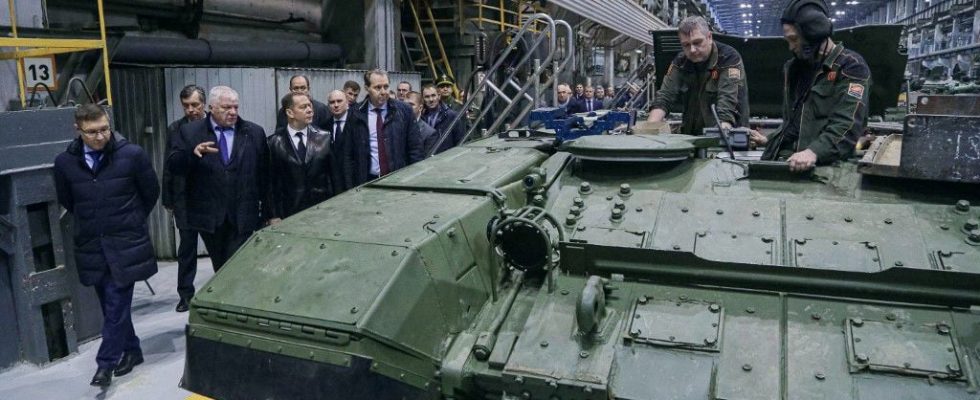The brand new T-90 tank heads in a straight line at the edge of a forest. After a few meters, he roars his cannon in a spray of flames. Then, on a saturated guitar riff, a sequence begins retracing its manufacturing process. The video of this armored vehicle – just coming off the assembly lines at the Uralvagonzavod factory, in Nizhny Tagil, in the Urals – is one of many published on social networks by the famous Russian manufacturer to serve its propaganda . And at the same time, that of the Kremlin. More than a year and a half after the start of the conflict in Ukraine, Russian factories are in working order to cover the needs of the army.
Moscow does not skimp on means. With $109 billion planned for 2024, or 6% of Russian GDP, military spending should represent nearly a third of the state budget. At the expense of funds allocated to education or health, frozen for the moment. “The Russian economy is largely mobilized for war, adds Julien Vercueil, economist specializing in Russia and vice-president of the National Institute of Oriental Languages and Civilizations. A significant part of civilian resources is diverted to satisfy the effort of war wanted by Vladimir Putin.”
Shift work, seven days a week
This mobilization does not escape the Ukrainian general staff. “The capabilities of the military industry are increasing, despite the introduction by the leading countries of the world of unprecedented sanctions against the aggressor country,” worried the commander-in-chief of the Ukrainian forces, Valeriy Zaluzhny, in The Economist, on November 1st. According to a study Ukrainian company of the Yermak-Mc Faul group, 67% of the foreign components used in the manufacture of Russian drones come from China, while Japanese, South Korean or Swiss chips and processors have also been found, marginally, in certain aircraft.
At the same time, in Kazan, Irkutsk and Yekaterinburg, several Russian manufacturers of military aircraft, combat helicopters, drones and guided munitions have expanded their installations, according to satellite images analyzed at the end of October by the Ukrainian media Skhemy/RFE/RL. “In October 2022, Russia was producing around 40 long-range missiles per month. Today, it’s around a hundred,” notes Jack Watling, researcher at the Royal United Services Institute, in a report. Enough to strengthen Russian strike capabilities at a time when Ukraine fears a new massive targeting of its energy infrastructure.
From 2022, a number of arms factories have started working three shifts, seven days a week. “In one year, the production of tanks has increased sevenfold, that of light armored vehicles such as BMPs or BMDs, by 4.5”, said Sergei Tchemezov, CEO of the state conglomerate Rostec, on the public channel Rossiya-24 in early November. Four months earlier, Russian Industry Minister Denis Manturov assured that monthly ammunition production now exceeded the volumes produced in 2022.
Doubts about real quantities
It is difficult, however, to take these assertions literally, in the absence of clear data. “Russia seems to have increased its arms production, but the scale of certain announcements seems hard to believe. And we do not see traces of this in other sectors such as the steel industry, while we could expect it to increase its activity in a symmetrical manner, points out Tomas Malmlöf, researcher at the Swedish Defense Research Agency. There is an element of strategic communication and propaganda in these announcements.” The objective: to maintain the narrative of a Russian defense industry with disproportionate capabilities, as in the Soviet era.
Before the war, it was capable, according to the estimates, to produce around 250 tanks (new and modernized) per year. “To drastically increase production, it is not enough to accelerate production rates in existing factories,” underlines Mark Cancian, senior advisor at the Center for Strategic and International Studies in Washington. supply chains, hiring workers and training them: this process takes years.” In the United States, the arms company Lockheed Martin has planned, in 2022, a period of four years to double its annual production of Javelin missile launchers, going from 2,100 units to 3,960 by 2026.
In addition, the announced volumes do not seem capable of making up for Russian losses. Last spring, the head of the Kremlin set the objective of building and modernizing 1,600 tanks by 2026. Although important, this figure is far from covering the losses (around 2,500 armored vehicles, according to the countdown from the specialized site Oryx). Shell production, for its part, could reach 2 million units per year, far from the 10 to 11 million used by Russian forces since the start of the conflict. “Even with the help of North Korea, the Russians cannot maintain such an expenditure of munitions,” notes Mark Cancian. “They will still be able to fight at a high level, but they will have to prioritize the targets.” The war is here to stay.
.
